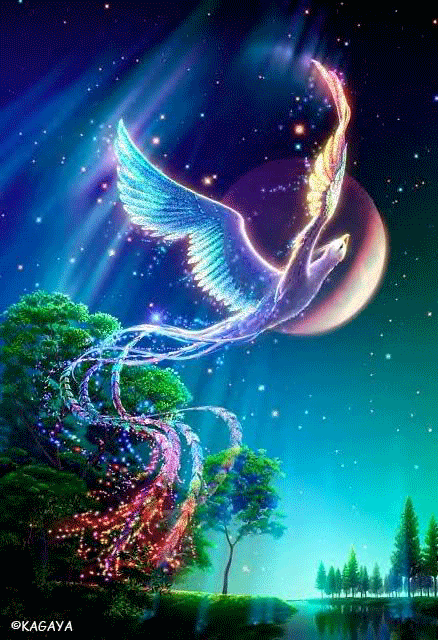|

art by: http://www.kagayastudio.com/english/

Mythology has always been a subject of interest and excitement for human beings. One of the most important characteristics of mythology are the colorful and interesting characters that are thrown towards the readers. Of course, most of the characters are exaggerated, but then, we have no proof that such characters did not exist or did not have the virtues and characterizations that are said to be theirs. The phoenix bird is one such mythical creature that has garnered the interest of generations of humans.
Immortality, vision, always seeing things beyond our lifetime, that is the Phoenix. The Phoenix is a mythical bird of tranquility and peace. It never dies; it always flies, staying well ahead, always looking. Many cultures have this Phoenix although in different forms and appearances. The Egyptians called theirs Bennu. The remains of a huge heron dated over 5,000 years ago were found in the Persian Gulf. Perhaps they saw this bird on occasion and the rarity of it led them to believe it was Bennu.
The Bennu was there at creation of the Nile and represents the god of time, hours, day, night, weeks, and years. It was considered the soul of the sun god, controlling the rising and setting of the sun. It was also believed that it resurrected life and death.
The Arabian Phoenix was more colorful than Bennu, and as big as an Eagle. It was said that every morning it would sing. The sun god Apollo would always stop just to listen to its beautiful melody.
Only one Phoenix lived at a time. Life span could be from 500 to 5000 years, maybe longer. When death approached the Phoenix built a nest of spices and branches then setting it on fire. And with it the Phoenix. Three days later the Phoenix arises from the ashes. A rebirth , new life, the Rise of the Phoenix. The new Phoenix takes the ashes of the old placing them into an egg of myrrh and places them on the alter of the sun god. So how does the Phoenix survive? It kills nothing, it crushes nothing, so what does it eat? The dew from the round gives substance to the Phoenix.
Feng Huang is the Chinese equivalent. To them it symbolizes virtue, grace, power and prosperity. To decorate a house with the symbol of a Phoenix meant the owners were honest people.
It was often shown with its wins spread capturing snakes with its talons. It was said to carry two scrolls in its bill, and emblems of the Phoenix decorate houses, tombs, and even jewelry.
Ho-Oo is the Japanese Phoenix. Legend has it that it only appears in peaceful and prosperous times, or at the birth of a virtuous ruler. Ho represents the male bird and Oo is the female. This Phoenix represents, sun, justice, fidelity, and obedience.
Scholars now think that the germ of the legend came from the Orient and was adopted by the sun-worshipping priests of Heliopolis as an allegory of the sun's daily setting and rebirth. Like all great myths, it stirs deep chords in man. In Christianart the resurrected phoenix became a popular symbol of Christrisen from the grave. Strangely, its name may come from a misunderstanding by Herodotus, the Greek historian of the 5th century BC. In his account of the bird he may have mistakenly given it the name "phoenix" because of the palm tree (Greek: phoinix) on which it was customarily pictured sitting in those days. In their attempts to identify the gorgeously plumed phoenix of Egyptian myth with a real bird, scientists tended to discount New Guinea's birds of paradise otherwise likely candidates because of the island's great distance from Egypt.
In 1957, however, Australian zoologists discovered that New Guinea tribes had exported bird of paradise plumed skins for centuries and that among those visiting the island, as long ago as 1000 BC, had been traders from Phoenicia in the Middle East. Another significant discovery was that the tribes people used to preserve the skins for export by sealing them in myrrh, molding them into an egg shape, and wrapping this in burned banana skins — a procedure that tallies almost exactly with the mythical bird's reputed treatment of its destroyed nest. Perhaps most significant of all is the fact that the brilliantly colored males of Count Raggi's bird of paradise are adorned with cascades of scarlet feathers that, during their courtship dance, they repeatedly raise aloft, while quivering intensely — a spectacle reminiscent of the phoenix dancing in its burning nest. On reaching the Middle East, descriptions of this spectacle, combined with the egg-like parcels of skins, may well have been sufficient to inspire the myth of the phoenix.
In all these cultures the Phoenix have several things in common. Sun, virtue, honesty, and its gentleness. The only difference is its appearance.
sources:
http://www.buzzle.com/articles/phoenix-bird.html
http://www.angelicinspirations.com/page314.htm
background and graphics by:

Next Back Home
|